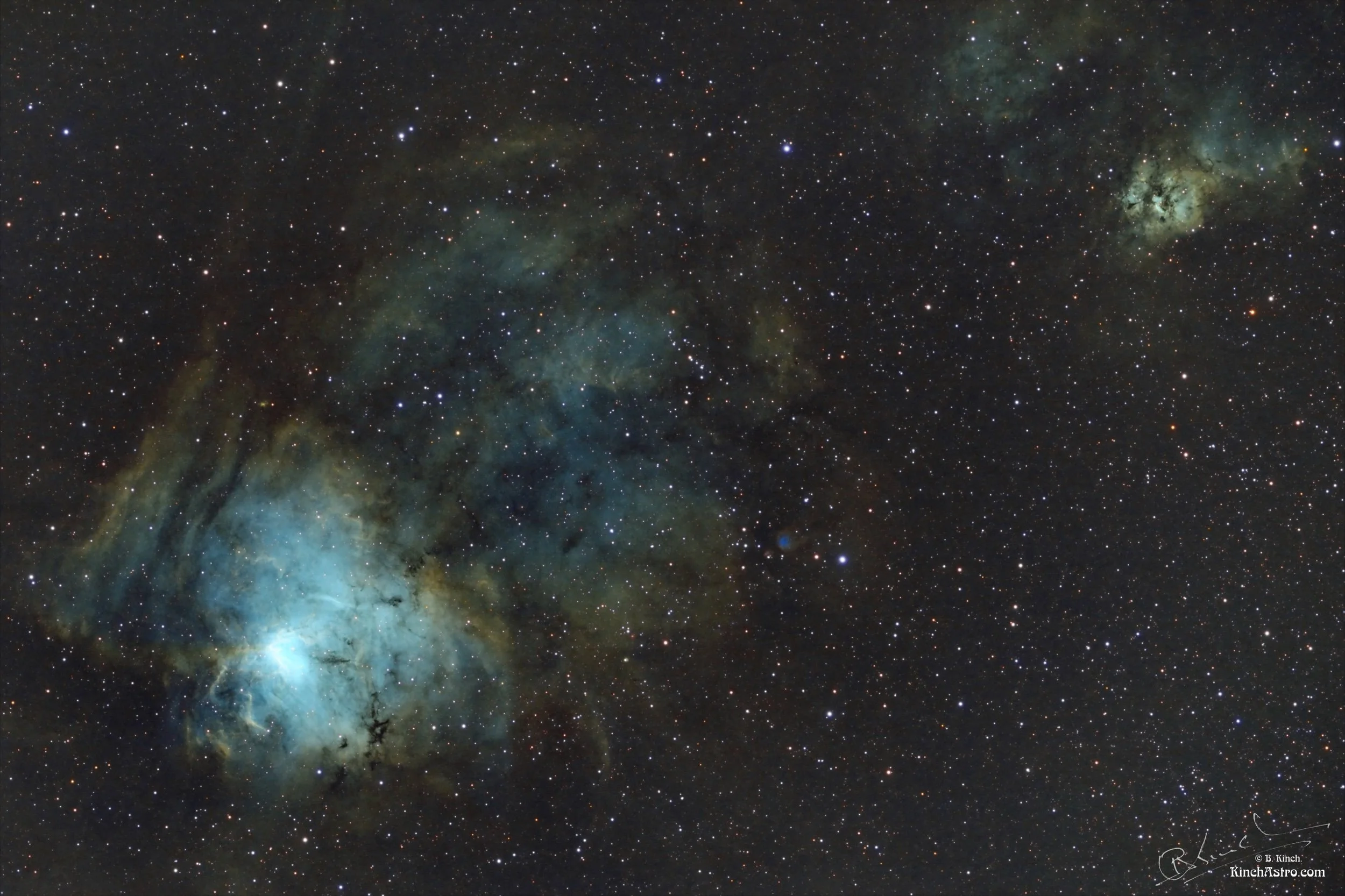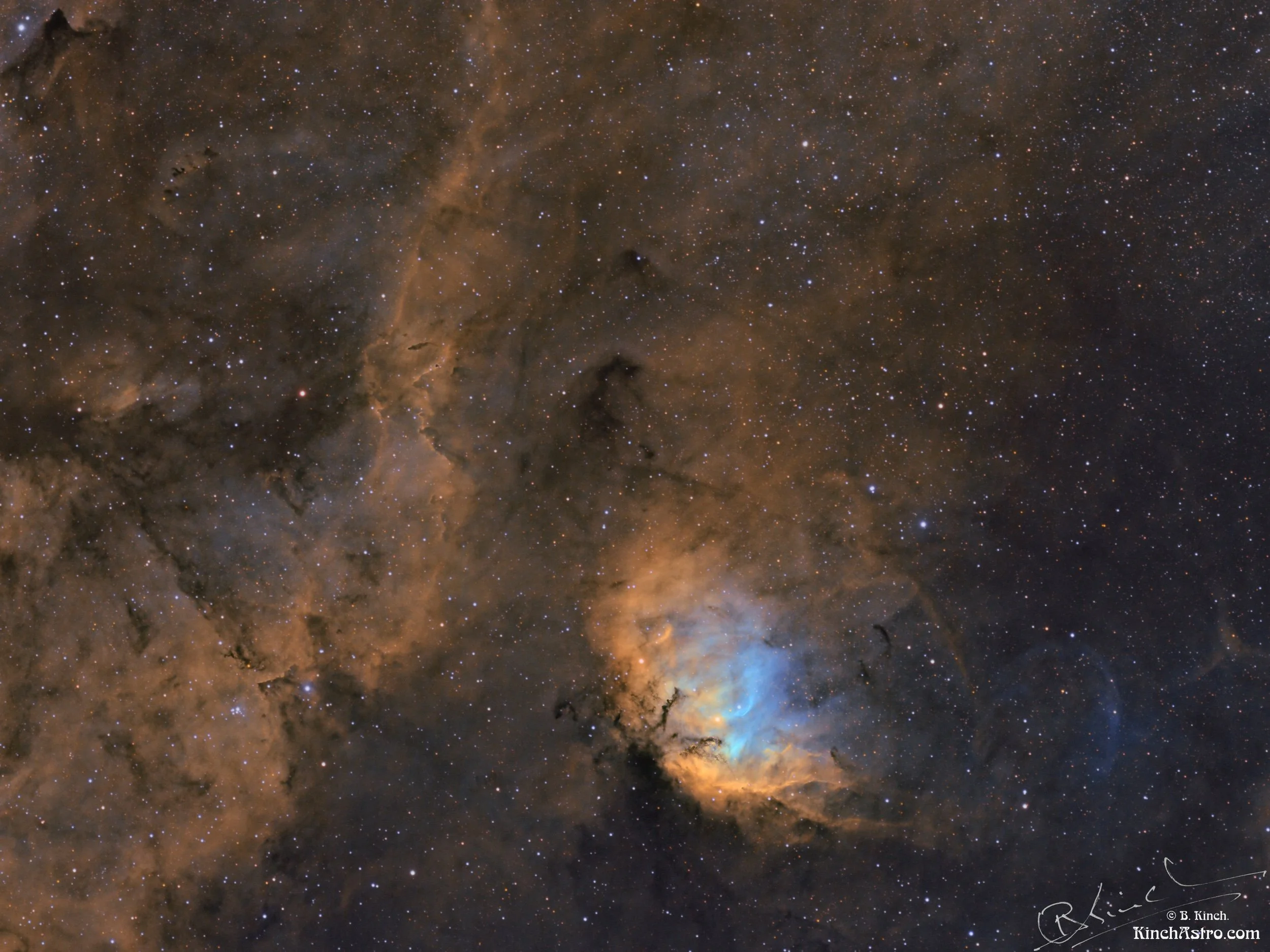
AAPOD2 Image Archives
NGC 1491 - The Fossil Footprint
Image Description and Details : Located on the edge of a vast cloud of natural gas, about 10,700 light-years away in the constellation Perseus, NGC 1491 (also called the Fossil Footprint) is an H II region (a large, low-density cloud of partially ionized gas in which star formation has recently taken place). Its central star (BD +50 886), is a young blue star with an 11.22 magnitude whose stellar winds are blowing a bubble in the surrounding gas.
Imaging telescopes or lenses: Takahashi FSQ130ED
Imaging cameras: ASI 2600MM
Mounts: Takahashi EM 400 Temma 2M
Guiding telescopes or lenses: Takahashi FS60CB
Guiding cameras: QHY CCD QHY 5 II
Focal Extender / Reducer: None
Software: Sequence Generator Pro SGP (for capture) PHD 2 (guiding), Astro Pixel Processor & PixInsight,
Filters: Astrodon Ha (3nm), Astrodon OIII (3nm), Astrodon SII (3nm),
Accessories: ATIK EFW3, SeleTEK2 controlling Robofocus Focuser.
Original Image : 5100 x 3400
Dates: 5th - 18th Jan 2023
Frames:
Astrodon Ha 42 x 10'
Astrodon OIII 36 x 10'
Astrodon SII 30 x 10'
Total integration = 18 Hours.
Copyright: Brendan Kinch
IC 4685
Image Description and Details : IC4685 can be found in the constellation of Sagittarius, very close to and often shown as part of the Lagoon Nebula. This area is rarely imaged on its own because of the more common photographic targets of M8 (Lagoon) and M20 (Trifid) being much more dominant in this area. The estimated distance is about 4000 light years away. The area of the image contains both emission and reflection nebulae and the open star cluster NGC 6546. Imaging telescope: Takahashi FSQ106ED Imaging camera: QSI 6120i Mount: Takahashi EM 400 Temma 2M Guiding telescope: QHY Mini Guide Scope Guiding camera: QHY CCD QHY 5L II Focal Extender / Reducer: 0.73X Capture Software: Sequence Generator Pro, PHD 2 Processing Software: Astro Pixel Processor, PixInsight, Topaz DeNoise, Photoshop Filters (1.25"): Astrodon SII 5nm, Ha 5nm & OIII 5nm Accessories: ATIK EFW2, SeleTEK2 controlling Robofocus Focuser. Dates: 27th Jun - 10th July 2022 Frames: Astrodon SII 12 x 15' Astrodon Ha 12 x 15' Astrodon OIII 20 x 15' Total integration = 11 Hours
Copyright: Brendan Kinch
Sh2-101
Image Description and Details : Sharpless 101 (Sh2-101) is a H II region emission nebula located in the constellation Cygnus. It is sometimes also called the Tulip Nebula because it appears to resemble the outline of a tulip when imaged photographically. It was catalogued by astronomer Stewart Sharpless in his 1959 catalogue of nebulae. It lies at a distance of about 6,000 light-years (5.7×1016 km; 3.5×1016 mi) from Earth.
Sh2-101, at least in the field seen from Earth, is in close proximity to microquasar Cygnus X-1, site of one of the first suspected black holes. Cygnus X-1. The companion star of Cygnus X-1 is a spectral class O9.7 Iab supergiant with a mass of 21 solar masses and 20 times the radius of the Sun. The period of the binary system is 5.8 days and the pair is separated by 0.2 astronomical units. The black hole has a mass of 15 solar masses and a Schwarzschild radius of 45 km. A bowshock is created by a jet of energetic particles from the black hole as they interact with the interstellar medium can be seen as an arc (bluish) to the right of the "Tulip".
Imaging telescope: Takahashi FSQ130ED
Imaging camera: ASI 2600MM
Mount: Takahashi EM 400 Temma 2M
Guiding telescope: Takahashi FS60CB
Guiding camera: QHY CCD QHY 5 II
Focal Extender / Reducer: None
Capture Software: Sequence Generator Pro, PHD 2
Processing Software: Astro Pixel Processor, PixInsight, Topaz DeNoise, Photoshop
Filters (50mm): Astrodon Ha (3nm), Astrodon SII (3nm) & Astrodon OIII (3nm)
Accessories: SeleTEK2 controlling Robofocus Focuser, ATIK EFW3
Dates: 29th May 2022
Frames:
Astrodon Ha 9 x 10'
Astrodon SII 9 x 10'
Astrodon OIII 9 x 10'
Total integration = 4 Hours 30 Mins
Copyright: Brendan Kinch
LBN 437 (SH2-126)
Image Description and Details : Data reprocessed under cloudy skies in March '22
LBN 437 is a molecular cloud in the constellation Lacerta. It is located at the edge of the much larger emission nebula Sh2-126 and the star forming region Lacerta OB1. The densest part of LBN 437 (centre) is associated with some bright young stars, among which the variable star V375 Lacertae, which is an Herbig object, with strong Hα-emission. This star is also responsible for the excitation of some bipolar Herbig-Haro-Objects situated in the nebula (HH 808, HH 809, HH 398).
Imaging telescope: Takahashi FSQ130ED
Imaging cameras: FLI ML16200
Mounts: Takahashi EM 400 Temma 2M
Guiding cameras: QHY CCD QHY 5 II
Focal Extender / Reducer: Tak QE 0.73x
Software: PHD 2, Astro Pixel Processer, PixInsight , Sequence Generator Pro SGP
Filters: Astrodon Ha + Astrodon RGB
Accessories: ATIK EFW3
Dates: Oct 4 - Oct 9, 2021
Frames:
Astrodon Ha: 18 x 600"
Astrodon R: 26 x 180"
Astrodon G: 26 x 180"
Astrodon B: 28 x 180"
Astrodon L: 57 x 180"
Integration: 8 Hours 51 Mins.
Copyright: Brendan Kinch
Cederblad 51
Image Description and Details : Cederblad 51 (the central blueish areas) is a reflection nebula in the constellation of Orion. It is part of Sharpless 2-264, which is sometimes referred to as 'Orion's Head'.
Imaging telescope: Takahashi FSQ130ED
Imaging camera: FLI ML16200
Mount: Takahashi EM 400 Temma 2M
Guiding telescope: Takahashi FS60CB
Guiding camera: QHY CCD QHY 5 II
Focal Extender / Reducer: None
Capture Software: Sequence Generator Pro, PHD 2
Processing Software: Astro Pixel Processor, PixInsight, Topaz DeNoise, Photoshop
Filters (50mm): Astrodon RGB & Astrodon Ha (3nm)
Accessories: SeleTEK2 controlling Robofocus Focuser, ATIK EFW3
Original Image (Crop): 2700 x 2400
Dates: 6th Feb - 1st Mar 2022
Frames:
Astrodon Ha 60 x 10'
Astrodon R 75 x 3'
Astrodon G 40 x 3'
Astrodon B 60 x 3'
Total integration = 18 Hours 45 Mins
Copyright: Brendan Kinch
SH2-261 / Lower's Nebula
Image Description and Details :
Lower's nebula (Sh2-261) is found on the outermost edge of our Milkyway between the Orion and Perseus arm. Sh2-261 is a large faint region of predominantly ionized hydrogen. The nebula is named after Harold and Charles Lower who discovered this nebula in 1939.
Embedded within Sh2-261 is LBN 862 and LBN 864. Also there are several dark nebulae in this field.
Imaging telescopes or lenses: Takahashi FSQ130ED
Imaging cameras: QSI 6120i
Mounts: Takahashi EM 400 Temma 2M
Guiding telescopes or lenses: Takahashi FS60CB
Guiding cameras: QHY CCD QHY 5 II
Focal Extender / Reducer: Tak QE 0.73x
Software: PHD 2, Pleiades Astrophoto PixInsight , Astro Pixel Processor (for stacking), Sequence Generator Pro SGP (for capture)
Filters: Astrodon Ha, SII, OIII,
Accessories: Robofocus Focuser, ATIK EFW3
Original Resolution: 3600x 2400
Dates: 3rd Nov - 8th Nov '21
Frames:
Astrodon Ha 18 x 20'
Astrodon SII 24 x 20'
Astrodon OIII 30 x 20'
Total Time: 24 Hours
Center (RA, Dec): (92.351, 15.689)
Center (RA, hms): 06h 09m 24.153s
Center (Dec, dms): +15° 41' 18.668"
Size: 80.7 x 53.8 arcmin
Radius: 0.808 deg
Pixel scale: 1.34 arcsec/pixel
Orientation: Up is 180 degrees E of N
Copyright: Brendan Kinch
DWB 111 & LDN 909
Image Description and Details : Commonly known as the propeller nebula the ‘propeller’ shape actually consists of two catalogued parts: DWB 111 & DWB 119.
The DWB catalog was compiled by H. R. Dickel, H. Wendker and J. H. Bieritz cataloging 193 distinct objects as part of their study of H-alpha emission nebula in the Cygnus X region of the sky.
This is part of a much larger complex known as Simeis 57 in Cygnus, discovered in the early 50’s. The distance to the nebula is not known.
DWB 111 is just a small part on the left of this image. There is another very faint OIII object in the frame & I hope I can add further to the image at a later date. LDN 909 refers to the dark area just right of centre.
Imaging telescope: Takahashi FSQ130ED
Imaging cameras: FLI ML16200
Mounts: Takahashi EM 400 Temma 2
Guiding cameras: QHY CCD QHY 5 II
Focal Extender / Reducer: Tak QE 0.73x
Software: PHD 2, Astro Pixel Processer, PixInsight , Sequence Generator Pro SGP
Filters: Astrodon SII, Ha, OIII, + Astrodon RGB
Accessories: ATIK EFW3
Original Resolution: 4416 x 33596
Dates: Jul 18 - Aug 4, 2021
Frames:
Astrodon Ha: 42 x 600"
Astrodon SII: 45 x 600"
Astrodon OIII: 48 x 600"
Astrodon RGB: 3 x 10 x 180"
Integration: 24 Hours.
Copyright: Brendan Kinch








